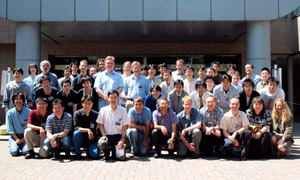On 24-26 June in an old city of Matsumoto in Nagano prefecture, an inter-disciplinary collaboration on photon detector, the International Conference on Photon Detectors, or PD09, presented many exciting progresses in studies of photon detectors of the past two years. Initiated in Kobe two years ago by the International Linear Collider (ILC: read about ILC at PD09) and the T2K neutrino experiment teams at KEK and other institutes, the biyearly conference is intended to provide a venue for discussion of the recent development in photon-sensors. This year it was attended by 55 photon-sensor experts in the field of high-energy physics, nuclear physics, cosmic-ray physics and medical science, along with three companies-Hamamatsu, SEIKO EG&G and General Electric.
|
|

PD09 participants gather for a group photo just outside the conference room on Shishu University's campus.
|
Photomultiplier tubes (PMTs) are well-known photon sensors, employed in experiments like Super-Kamiokande to detect Cherenkov light from cosmic-ray neutrinos. Now of growing interests are what are called pixelated photon detectors (PPDs), such as multi-pixel photon counter (MPPC) of Hamamatsu, which attain large gain and photon detection efficiency through electron avalanches in the presence of an electric field. The compactness, low operation voltage, and their insensitivity to magnetic field are preferable in high-energy particle physics experiments, but the temperature sensitivity and the susceptibility to radiation need to be well understood.
The first ever application of PPDs was to T2K, Tokai-to-Kamioka long baseline neutrino oscillation experiment in Japan, which just saw the first successful beam in April. During its one-year shipment period from Febuary 2008 to February 2009, Hamamatsu had successfully shipped out the total of 63,855 pieces to T2K experiment without failure. Prof. Yury Kudenko of the Institute for Nuclear Research in Moscow stressed in his summary talk that in his view "the actual MPPC product is the most exciting achievement, an important progress in real applications in real experiment." In the mass test conducted during the March to September period last year in Kyoto, they've found only few bad MPPCs, and now T2K is about to operate 35,000 of them in five detectors.
Among the five detectors the very first detector to deploy MPPCs is the detector called Interactive Neutrino GRID (INGRID), installed 280 meters from the neutrino source to monitor the beam direction. Masashi Otani of Kyoto University, who has been working on its development through installation and testing, now prepares for the beam commissioning scheduled in this fall. Another detector, installed in the direction of Kamioka--2.5 degrees off the beam direction--is the fine-grained detector (FGD), one of the near detector to measure energies and fluxes of neutrino beams. Kei Ieki of Kyoto University presented the results from the beam tests at TRIUMF in Canada just completed in May this year. "It is the most exciting time for me," says Ieki. "The FGD are on its way to J-PARC from Canada, and the installation this fall will be followed by actual data taking in the winter."
The PMT technology has been advancing as well; hybrid avalanche photon detector (HAPD) developed by the Belle collaboration at KEK is a promising candidate for photon-sensors to be implemented in the aerogel RICH (ring imaging cherenkov counter) detector that will replace the aerogel Cherenkov counter (ACC) currently installed at Belle. "We are able to get very clear single photon peak using 144 channel HAPD," explains Dr. Shohei Nishida of KEK, who has been working on the frontend electronics for the detector. Over the past year, his team has studied background noises with more detailed configuration of HAPD, analyzed data from beam test, and tested it under magnetic field. To prove feasibility of the detector, yet further test on its radiation hardness is necessary before Nishida starts designing the readout electronics that communicate with the central system.
"Though the HAPD was not a big topic in the conference, there were things that will help us in future, such as the installation of large number of MPPCs we heard from T2K, as we will be going through the similar process," says Nishida. Attended by scientists from many research projects, the second conference saw the stronger collaboration among the projects than the first. "It was fascinating to learn that there are so many ongoing projects that use PDs around the world," says Otani. "Also, it is beneficial for me to share and discuss the data from INGRID with people from other projects, and the conference was a good place to start."
|



